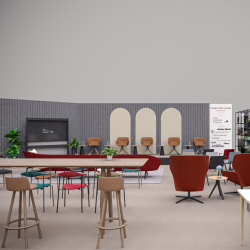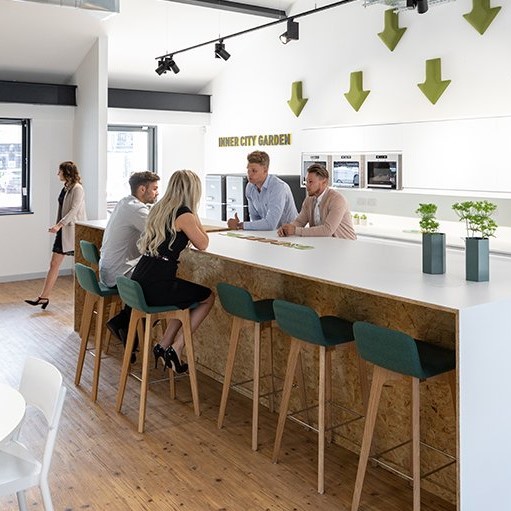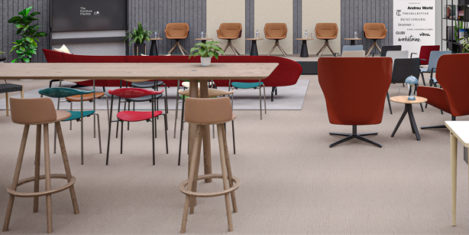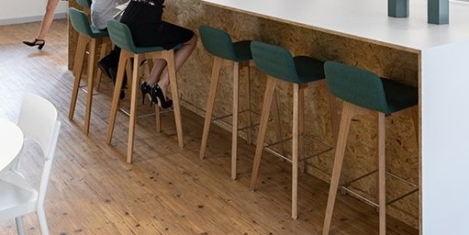October 26, 2021
Search Results for: environment
October 25, 2021
Impact of flexible work demonstrates a fragile post-pandemic business world
by Jayne Smith • Flexible working, News
 Lucid and Vitreous World, have launched the results of new research that surveyed individuals across the UK to analyse employee sentiment and the impact of flexible work as a direct result of the pandemic. (more…)
Lucid and Vitreous World, have launched the results of new research that surveyed individuals across the UK to analyse employee sentiment and the impact of flexible work as a direct result of the pandemic. (more…)
October 25, 2021
Just two weeks to go until the inaugural Workspace Design Show
by Freddie Steele • Company news, Workplace design
 In just two weeks, the much-anticipated Workspace Design Show will open its doors for the first time, welcoming the commercial interiors community to discover and discuss tomorrow’s places of work at London’s Business Design Centre from 4-5 November 2021. (more…)
In just two weeks, the much-anticipated Workspace Design Show will open its doors for the first time, welcoming the commercial interiors community to discover and discuss tomorrow’s places of work at London’s Business Design Centre from 4-5 November 2021. (more…)
October 22, 2021
Employee experience is more important than ever
by Lizzie Rolley • Comment, Wellbeing, Working culture, Workplace
 Employee experience has never been so high on the corporate agenda; with recent figures finding that over 69 percent of businesses are currently concerned about talent shortages and difficulty hiring. With this in mind, organisations that want to grow must provide a market leading experience in order to remain competitive and attract and retain new talent. Companies that invest in their unique employee experience make four times more profit than those who don’t. (more…)
Employee experience has never been so high on the corporate agenda; with recent figures finding that over 69 percent of businesses are currently concerned about talent shortages and difficulty hiring. With this in mind, organisations that want to grow must provide a market leading experience in order to remain competitive and attract and retain new talent. Companies that invest in their unique employee experience make four times more profit than those who don’t. (more…)
October 22, 2021
HR leaders’ number one priority for 2022 is building critical skills and competencies
by Jayne Smith • News, Working culture, Workplace
 Nearly 60 percent of HR leaders reported that building critical skills and competencies will be their number one priority in 2022, according to a survey by Gartner, Inc. The survey of more than 550 HR leaders in July 2021, claims the other top HR priorities for 2022 are: organisational design and change management (48 percent), current and future leadership bench (45 percent), the future of work (42 percent) and diversity, equity and inclusion (DEI) (35 percent). (more…)
Nearly 60 percent of HR leaders reported that building critical skills and competencies will be their number one priority in 2022, according to a survey by Gartner, Inc. The survey of more than 550 HR leaders in July 2021, claims the other top HR priorities for 2022 are: organisational design and change management (48 percent), current and future leadership bench (45 percent), the future of work (42 percent) and diversity, equity and inclusion (DEI) (35 percent). (more…)
October 22, 2021
Helping the planet one chair at a time
by Freddie Steele • Company news, Environment
 For Rainbow, looking out for the planet is just as important as taking care of clients. This is why they have been working hard to acquire the environmental standard ISO 14001, of which they have recently been accredited. Rainbow believes that receiving this attribution is important in illustrating their ongoing environmental commitments. (more…)
For Rainbow, looking out for the planet is just as important as taking care of clients. This is why they have been working hard to acquire the environmental standard ISO 14001, of which they have recently been accredited. Rainbow believes that receiving this attribution is important in illustrating their ongoing environmental commitments. (more…)
October 21, 2021
One in five Brits left in dark over return-to-office plans
by Jayne Smith • Flexible working, News, Working lives
 Millions of British workers face uncertainty as a snapshot of the nation’s work practices claims that one in five employees are unsure whether they’ll be expected to work remotely, onsite, or a mix of both in the future. Without having a clear decision from their employer, some employees are unsure about their organisations’ return-to-office plans. (more…)
Millions of British workers face uncertainty as a snapshot of the nation’s work practices claims that one in five employees are unsure whether they’ll be expected to work remotely, onsite, or a mix of both in the future. Without having a clear decision from their employer, some employees are unsure about their organisations’ return-to-office plans. (more…)
October 20, 2021
Hybrid work attitudes – leadership still face challenges aligning their strategy
by Jayne Smith • Business, Flexible working, News
 Results from Howspace’s new global survey indicate that despite 94 percent of surveyed respondents feeling well-equipped to transition to a hybrid work model, leadership teams still do not have clarity for how to lead teams and work together with people as the results show very different preferences for sharing their thoughts and opinions within an organisation. (more…)
Results from Howspace’s new global survey indicate that despite 94 percent of surveyed respondents feeling well-equipped to transition to a hybrid work model, leadership teams still do not have clarity for how to lead teams and work together with people as the results show very different preferences for sharing their thoughts and opinions within an organisation. (more…)
October 20, 2021
Toxic workplace culture impacting the mental health of almost half of UK’s workforce
by Jayne Smith • News, Wellbeing, Working culture
 Two in five employees across the UK have experienced problematic behaviour, such as bullying, harassment or discrimination at work; with 42 percent confirming toxic workplace culture has impacted their mental health, according to recent research from Culture Shift. (more…)
Two in five employees across the UK have experienced problematic behaviour, such as bullying, harassment or discrimination at work; with 42 percent confirming toxic workplace culture has impacted their mental health, according to recent research from Culture Shift. (more…)
October 19, 2021
So what’s happening to all the plexiglass we thought was a solution last year?
by Mark Eltringham • Comment, Environment
 In 2008, the philosopher and ecologist Timothy Morton coined the term hyperobject to describe things that can’t be seen directly or experienced at a point in time or space but which are nevertheless vast and important. The example he gives is Styrofoam. We might be able to see a small number of cups or fast-food trays, but what we can’t see is all the Styrofoam ever produced. It is a hyperobject and one that will last for at least 500 years, even if we stopped producing it today. (more…)
In 2008, the philosopher and ecologist Timothy Morton coined the term hyperobject to describe things that can’t be seen directly or experienced at a point in time or space but which are nevertheless vast and important. The example he gives is Styrofoam. We might be able to see a small number of cups or fast-food trays, but what we can’t see is all the Styrofoam ever produced. It is a hyperobject and one that will last for at least 500 years, even if we stopped producing it today. (more…)
October 19, 2021
Organisations prioritise technologies for the year ahead
by Jayne Smith • Business, News, Technology






 Nearly two thirds (61 percent) of HR and people professionals strengthened their skills – through either upskilling or reskilling – as a result of their organisation’s response to the COVID-19 pandemic, the latest People Profession survey report from the
Nearly two thirds (61 percent) of HR and people professionals strengthened their skills – through either upskilling or reskilling – as a result of their organisation’s response to the COVID-19 pandemic, the latest People Profession survey report from the 









 A new report by
A new report by 








October 25, 2021
The power of science can help companies create better menopause policies
by Gosia Bowling • Comment, Wellbeing